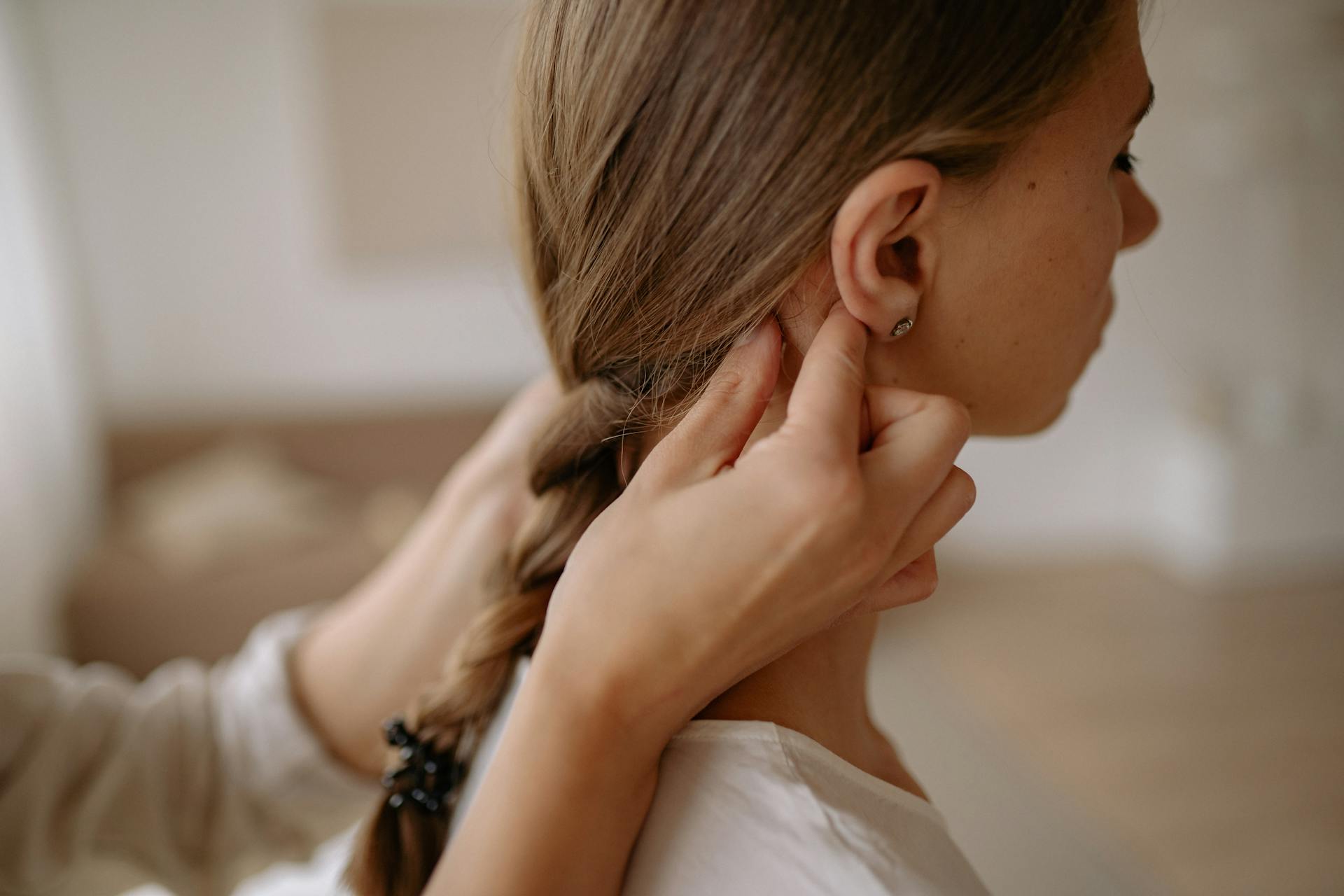As you’ve gotten older, has starting (or ending) the day with neck pain become a normal part of your routine? You’re certainly not alone. Sometimes it’s from hunching over a laptop or pushing too hard at the gym, but for more than half of people over 40, neck arthritis — also known as cervical spondylosis — may be to blame.
If you live with neck arthritis, you might already use a few go-to remedies when it flares up, like a heating pad on the couch or some light stretching when you’re especially stiff. But what about massage therapy? Is massage good for neck arthritis — and if so, what are the best ways to try it?
Here’s everything you should know about massage for neck arthritis, including its benefits, safety tips, and additional steps for relief.
An Overview of Neck Arthritis
Put simply, neck arthritis (medically known as cervical spondylosis) is a term that refers to pain and joint degeneration in the neck. The cervical spine is made of seven stacked bones (also called vertebrae) that make millions of tiny micromovements throughout your lifetime. As you age, the cartilage between these joints naturally wears down — and for many, that wear and tear shows up as neck arthritis pain.
Aside from pain and stiffness, neck arthritis can also impact your mood, disrupt your sleep, and, in more serious cases, even involve the spinal nerves.
The good news is that mild cervical spondylosis usually responds well to gentle, non-invasive treatment options like physical therapy or medications. And along the way, your doctor can help you decide whether complementary tools like massage could be worth a try.
Risk Factors
Since cervical spondylosis is most common in older adults — affecting up to 85% of people over 60 — it probably comes as no surprise that age is a leading risk factor. But aside from getting older, here are a few other things that may increase your odds of developing neck arthritis in your lifetime:
- Having a job that requires a lot of neck strain and repetitive movements, like auto mechanic work, construction, housekeeping, driving, or computer work
- Genetics, as some people can have biological or anatomical differences that make them more prone to arthritis
- Smoking, which has been linked to cervical disk degeneration and neck pain
- Previous neck injuries, like whiplash, herniated disks, or other direct trauma
How Is Neck Arthritis Treated?
Treating neck arthritis is typically about managing pain, preventing future joint degeneration, and boosting overall quality of life — which often comes down to finding the right blend of self-care and pain relief tools that work for you. Some common options include:
- Medications like muscle relaxers, NSAIDs like ibuprofen, or corticosteroids
- Physical therapy to help strengthen the muscles that support the neck
- Self-care tools and practices, such as regular exercise, heat, ice, or a lightly supportive neck brace
- Surgery in more serious cases (like those involving nerve pain or severe joint degeneration)
Can Massage Therapy Help Neck Arthritis? The Potential Benefits
If you’re already using some traditional treatments for neck arthritis, you might wonder: Is massage therapy worth adding to your routine?
While it can’t cure or treat arthritis, the right techniques can often be a wonderful complementary tool for boosting well-being, supporting blood flow, and managing stiffness when it comes up. More specifically, it may help with:
Improved Range of Motion
For people with cervical spondylosis, one of the main challenges is that it can be harder to move, twist, or turn your neck without feeling more strain than usual. The good news is that regular, gentle massage may be able to make movement feel a little more comfortable.
In one small 2014 study, researchers looked at how weekly, moderate-pressure massage – plus daily self-massage – could impact neck arthritis symptoms. They found that in the short term, massage eased neck arthritis pain and improved range of motion during forward bending and side-to-side motions.
In-the-Moment Pain Relief
Beyond warming up stiff joints, massage can be a great tool for in-the-moment pain relief. According to the Arthritis Foundation, research so far suggests that massage can be a helpful complementary tool for many types of arthritis pain, though scientists are still learning how it best works for different forms of arthritis in different areas of the body. A few possible reasons behind its benefits could be:
- A decrease in stress and boost in emotional well-being – both of which can impact pain perception
- Loosening up tight muscle fibers, in turn helping reduce stiffness around achy joints
- Stimulating nerves in the skin and muscle tissue, which may temporarily reduce feelings of pain
Easing Reflexive Muscle Tension (Guarding)
When you have neck arthritis, the body sometimes responds by tensing up muscles to help guard joints that feel vulnerable or irritated. Short-term, this can be helpful for protecting certain kinds of injuries. But in the long run, this tension can worsen discomfort and may even create trigger points (or knots) that make arthritis feel all the more painful.
The good news? Targeted massage can help muscles relax back into their lengthened states — at the same time promoting endorphins (your body’s natural feel-good chemicals) and stress relief. And together, these effects may help calm the tension cycle that so often makes arthritis harder to manage.
Mood and Sense of Well-Being
When living with any type of chronic pain, the effects are often not always just physical — and with arthritis specifically, it’s common to notice a lower mood and higher stress alongside other symptoms. At the same time, mental health issues like depression can worsen arthritis pain or even trigger flare-ups, with one study finding that those with depression were 1.8 times more likely to also have cervical spondylosis.
Fortunately, massage’s effects on emotional well-being have been well-documented — having been shown to soothe stress on both a physical and emotional level. Beyond that, research suggests that it may even be helpful in improving mood and reducing feelings of depression in those living with chronic pain.
Safety Tips Before Trying Massage for Neck Arthritis
If you’ve been living with neck arthritis for a long time, it’s only natural to be curious about tools that could make your day-to-day better. But like with any complementary therapy, it’s important to be aware of the risks and considerations of your unique situation before trying massage. Be sure to check with your doctor if you:
- Have serious joint degeneration, herniated disks, or any injuries affecting the neck region
- Have osteoporosis or another condition impacting your bone health
- Are currently recovering from surgery
- Have varicose veins
- Have high blood pressure or other cardiovascular conditions
- Are dealing with a serious arthritis flare-up
- Have noticeable inflammation (swelling, redness, etc.) on or near the neck
How To Try Neck Massage for Arthritis: 4 Ways
Once you’ve got the all-clear to try massage, where do you start? Here are four potential options to explore, whether you want to try it in the comfort of your home or visit a professional massage therapist:
Easy Hands-On Massage
One of the easiest ways to try neck massage at home is to simply use your own two hands. The benefit of this method is that you can start as gently as you need to in order to figure out which pressure levels feel best to you. Plus, by knowing a few hands-on techniques, you can find relief anywhere — whether you’re flying, at the gym, or even on break at work. Here are the steps:
- Take a deep breath, and check in with your posture. (A useful tip is to imagine a string pulling your head upward to help align your spine.)
- Wrap both hands around the back of your neck.
- Apply a few broad compressions (or squeezes) along the back-of-neck muscles for one minute.
- Then, reach your right hand over your left shoulder to find your trapezius muscle — the large, diamond-shaped muscle that spans from your shoulder, across your back, and up the back of your neck.
- Use your fingers to massage this muscle in small circular motions. Start at the shoulder and move up toward the base of your skull, repeating for 45-60 seconds.
- Repeat on the other side.
- Next, make fists with both hands and align your knuckles with the back sides of your neck. Use gentle-to-moderate pressure to glide outward and downward on the muscles for one minute more.
Peanut Ball Massage Rolling
Another good option for quick relief? Simply roll out the muscles on the back sides of your neck. While it’s not quite as practical as hands-on massage, this method can be perfect for those long days at your desk or when you’re just feeling sore at home.
Using two massage balls or a peanut-shaped roller, you can apply slow, targeted pressure to the back of the neck, which can help with both all-over tension and smaller trigger points. Here’s how:
- Grab a small peanut-shaped massage roller. (Or, place two small massage balls side-by-side in a sock or secure bag.)
- Stand against a wall, situating the roller behind the top of your neck.
- Lean back gently, checking to make sure the rollers are resting on muscle tissue (and not any bony spots).
- Gently roll up and down for a few seconds. If light pressure feels good to you, you can gradually increase as needed. (Just be sure not to overwork anything.)
- Roll for a total of 1-2 minutes.
Opt for a Neck-Friendly Massager
If you’re looking to incorporate more massage into your routine without all the manual work, a neck-friendly massager can be a tool worth trying. The MedMassager Neck Massager is one option expertly designed to fit the contours of the neck muscles, all while using gentle kneading motions to deliver deep relief.
Beyond massaging the muscles, it also comes with the option to add heat — which can feel especially soothing when you’re dealing with joint tension and stiffness. Here’s how it works:
- Situate the massager around the back of your neck, using the straps to adjust it as needed.
- From there, power the massager to its low-pressure setting.
- Allow your muscles to warm up to the massage for one minute or so.
- Gently increase the pressure as needed, optionally adjusting the heat for even deeper relief.
Professional Massage
Home tools can be a good option for mild arthritis relief — but what if you want more in-depth, targeted massage? In this case, seeing a professional can be worth considering since they bring expertise in areas like body mechanics, mobility, and how the back-of-neck muscles interact with each other.
Additionally, when you’re dealing with a health condition, it can sometimes just feel safer and more comfortable to see a professional. If you have advanced arthritis or neck concerns, be sure to talk to your doctor about how massage can fit as part of your treatment plan. They may even be able to refer you to a medical massage therapist who has experience helping patients with symptoms similar to yours.
Massage Tips for Deeper Relief
Massage on its own can be a great way to promote circulation, loosen up muscle tissue, and ease mild aches and pains from neck arthritis. But for even more relief, here are a few other tips to consider using during (or after) your sessions:
- Apply some heat to help relax stiff tissue and promote blood flow. You can use a heat-powered massager like the one mentioned above. Or, simply apply a hot towel before starting your massage.
- Stretch your muscles. Try a few light neck circles or side-to-side bends to complement massage’s range of motion benefits.
- Don’t forget your other treatments and tools. Regular massage can work wonders for daily pain and stiffness relief, but it’s best used as part of a broader treatment plan to protect your long-term neck health.
Other Remedies and Treatments for Neck Arthritis
In the big picture, there are plenty of important steps you can take to treat cervical spondylosis — not only to ease pain, but also to manage the condition’s progression and improve your overall quality of life. With that said, here are some trusted treatments and remedies to keep in mind:
Physical Therapy
Physical therapists (PTs) are movement and body mechanic experts who help people treat and manage injuries and conditions like neck arthritis. When it comes to the neck specifically, a PT can help you build a tailored routine of stretches and strengthening movements to improve your symptoms and help keep your neck joints healthy over time.
With that said, not every PT exercise will work for everyone, but a few of the most commonly-recommended ones include:
- Neck tilts forward, backward, and side-to-side to help promote mobility
- Chin tucks (or gently pulling the chin back into a double-chin) to strengthen the deep flexor muscles and combat forward head posture
- Shoulder rolls to help loosen the shoulder and upper back muscles, decreasing any tension that might be “pulling” around the cervical spine
Lifestyle Shifts
Aside from movement, making a few small lifestyle shifts can also be a good way to reduce the strain on your neck joints. Simple things — like taking breaks at work to stretch and move your neck — can go a long way in boosting circulation and easing stiffness day-to-day.
Posture is often another major piece of the puzzle. Rounding forward, for example, is a common habit that can cause neck strain even when you don’t have arthritis. Fortunately, you can counteract it by remembering to keep your shoulders back, chest open, and head in line with your spine. It’s also worth checking to make sure that your sleep setup (and more specifically, your pillow) supports your neck properly.
Finally, while it might seem unrelated, it can help to take a look at your stress levels, too. Here’s why: stress can directly cause muscle tension, but it also impacts your pain sensitivity, sleep, and even your postural habits — all of which can affect how neck arthritis symptoms show up in daily life.
The Takeaway
So, is massage good for neck arthritis? As long as you get the green light from your doctor, it may bring some surprising benefits. A gentle, consistent routine can help promote healthy blood flow, ease pain, boost your mood, and reduce muscle stiffness – all of which can often help arthritis feel more manageable.
To get started, you can try a simple hands-on massage, rolling tools, or visiting a pro for your first session. But for regular neck massage blended with the power of heat at home, MedMassager’s HSA/FSA-eligible tools can help.
Pick up the MedMassager Neck Massager today to get started, or view more trusted home tools here.



